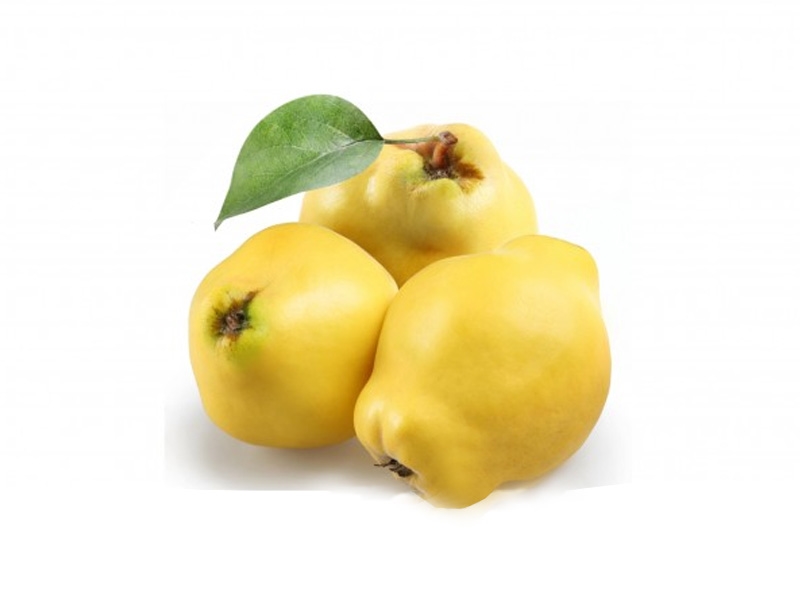Quince

Pineapple
2019-10-26
Raspberry
2019-10-26Common Name
Quince
Scientific Name
Cydonia oblonga
History
The quince tree is native to Southwest Asia, especially Iran and Anatolia. The first quince trees grew up in the Caucasus foothills. The fruit called Golden Apples in ancient times, was shipped from the Middle East to the Mediterranean region, and from there to the West and through the Silk Road transported to the East and China, known as Golden peach of Samarkand. Quince fruit was widely used all over the world since ancient times till late medieval even it was more popular than apples in some regions and countries. This fruit, thanks to its similarity to pears, was formerly known with the scientific name of Pyrus Cydonia, however; it was later registered as a distinct plant species and known with the scientific name of Cydonia oblonga.
Health Benefits
1. Improving Digestive System Function
In a study published in the Journal of Research in Pharmaceutical Science, the effects of quince juice and its hydro alcoholic extract on the treatment of wounded colitis (an intestinal inflammatory disease) has been investigated in laboratory mice with colitis. The results have shown that quince extract and juice effectively reduce wound colitis lesions. Other studies have shown that quince Catechin and Epicatechin control development of intestinal inflammations and gastric ulcer, helping to improve digestive system function. These compounds prevent gastric ulcers by making a protective layer in the stomach and reducing the leukocytes movement to the mucous.
2. Improving Liver Function
According to the researches, quince juice restrains the activity of ALT (alanine transaminase), AST (aspartate transaminase) and LPS liver enzymes, increases the activity of super oxidase dismutase (SOD), glutathione peroxidase (GSH-PX), lipoprotein lipase (LPL) and hepatic lipase and reduces fat in the fatty liver. This plant’s flavonoids were shown to protect the liver due to the increased antioxidant capacity and lipoprotein metabolism in the liver and inhibition of lipogenesis (fat production). Further studies have shown that this fruit skin contains a significant amount of antivirus agents, stopping the growth of microorganisms and agents of type A, B, and C hepatitis. Therefore; it is highly recommended to eat quince fruit every day in order to improve the liver function.
3. Improving Respiratory Tract Function
Studies have shown that pectin which exists in quince controls the phlegm and reduces inflammation of the respiratory system, tonsils and throat, while helping to treat respiratory disorders such as bronchitis and asthma. The results published in the Journal of the Scholars Academic Journal of Pharmacy have indicated that the quince grain extract reduces the constrictions caused by Carbachol and Potassium in the rabbit’s trachea tissue. In this respect, the quince grain extract acts like verapamil (a drug for controlling hypertension and heart rate abnormalities).
4. Regulating Blood Glucose Levels
According to a study published in the Journal of Pharmaceutical Research, the polyphenolic compounds of quince fruit have a hypoglycemic function, decreasing blood glucose levels significantly. These compounds eliminate the adverse side effects of diabetes. The study results have shown that treating diabetic mice in vitro with quince fruit extract reduces plasma and creatinine urea, while improving kidney function in diabetic mice. The fruit extract also protects the liver tissue through decreasing serum levels of AST, ALT and ALP in diabetic patients.
5. Regulating Blood Pressure
As indicated in the researches, flavonoids of quince fruit help in reducing blood pressure. According to a test conducted on mice with high blood pressures, the extract of Cydonia oblonga or quince fruit effectively reduces blood pressure after four weeks. After 8 weeks, the fruit extract functions like captopril. It decreases the level of angiotensin, Apelin and Endothelin as well as reducing blood pressure. The antihypertensive activity of this extract is due to its effect on the renin-angiotensin system.
6. Regulating Blood Cholesterol Levels
The results of a research study published in Ethnopharmacol in 2015 have indicated that the quince fruit flavonoids reduce total cholesterol, Triglyceride and LDL cholesterol in mice with high cholesterol after four weeks by regulating lipid metabolism and eliminating free radicals.
7. Boosting Libido
Studies have shown that the quince fruit extract significantly increases mating in sample mice compared to controlled mice. It increases libido because it contains flavonoids, glycosides and tannins.
8. Anti-cancer
According to a study, phenolic compounds in quince fruit protect the body from kidney cancer. These compounds have anti-proliferative activity against cancer cells. The fruit extract and its grain, at a concentration of 500 μg/ml, prevents growth and proliferation of cancer cells. This study has suggested that Cydonia oblonga can be used as an anticancer agent or even as a chemotherapy drug.
Bioactive Compounds
Tannin, Pectin, Mucilage, Sugar (Fructose, Glucose, Galactose, Sucrose), Organic acids (Citric, Ascorbic, Malic, Tartaric, Ferulic, Shikimic and Fumaric acids), Vitamins (A, B, C), Minerals such as Potassium (K), Free amino acids (Asparagine, Aspartic acid, Hydroxyproline).
Traditional Use
In Iranian traditional medicine, the sweet quince is known as having hot nature while its seed has a cold and wet nature, being effective in relieving Sputum and dry coughs, treating stomach heat and strengthening heart muscles. Avicenna has also written in his Book of Law: “Quince is helpful for treatment of abnormal uterine bleeding”. Quince fruit and seed are used to treat dizziness, mouth ulcers, diarrhea, vomiting, cough and insomnia.




